
A Cave of Candles / by Dorothy V. Corson

Chapter 18a
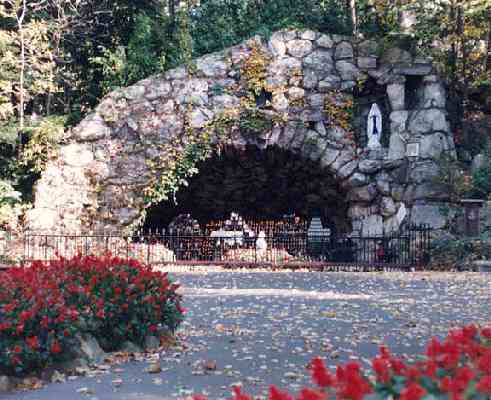
The Community Cemetery
Returning to the community cemetery to verify this information occasioned a visit to Father Jan's grave. Dappled sunshine made leafy patterns on his gravestone as I stood there musing over all the extraordinary events that had transpired since our first, seemingly providential, meeting. I would not be writing this story at all had it not been for his Fatherly friendship. Standing there lost in thought, I found myself fingering the pages of the past as I relived the day of Father Jan's funeral.
It was a beautiful sunshiny October day. After the graveside service in the community cemetery at Notre Dame, I drove back to St. Stan's to arrange to light candles at their Grotto. I tasted the deliciousness of a another golden day associated with the Grotto my father had built for him, absorbing the feel of it, and imprinting it on my mind so that in all my life I would never forget it. The trees raining color; breezes caressing the most delicate senses; the fragrance of leaf burning in the autumn air.
In returning to the campus to do the same at the Notre Dame Grotto, I decided that it was too nice a day to keep to myself. That I must share the memory with another little person as I had done with our six year old son, eleven years before after his grandfather's death. My five year old niece, Kelli, my father's youngest grandchild, was delighted with the prospect of visiting the campus and lighting a candle for the grandfather she never knew. As with our son, it was her first visit to the campus. She, too, was taken by the Grotto and so serious in her selection of just the right frame to place them in, one for her grandfather and one for Father Jan.
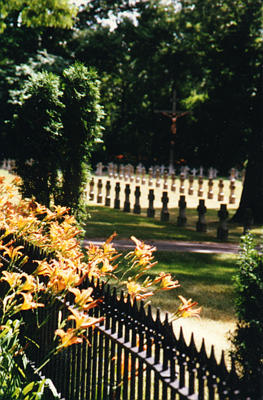
After we visited the lake and fed the ducks, we followed the winding road to the clearing in the woods where the white crosses marched in neat rows across the green grass. As she danced along the cemetery paths, she asked me to read the names. "So many Brothers, but where are all the Sisters," she asked, a bit perplexed. "Oh, they have a special place of their own," I explained. As we neared Father Jan's freshly seeded grave, we sat down on the grass and rested for awhile. I asked her if she would like to pick one of the colorful leaves, to press, to remember the day by. "It will be like a snapshot from a vacation trip," I told her, as I handed it to her. "Whenever you see this pretty leaf you will remember the day you lit candles at the Grotto and you'll feel all warm and glowing inside remembering it."
With her other hand, she reached for mine as we left, her little mind taking in all I had said. Then suddenly she stopped, after we had gone only a few paces, looked up at me searchingly and said: "Aunt Dottie, Mommy says you've been very good to Father Jan. Why were you so good to him?"
I paused a moment, savoring my thoughts, then gently squeezing her little hand, I looked down at her bright inquiring eyes and softly repeated a much loved phrase: "Because, little one," and I stroked her tawny hair, "he was a promise to myself I had to keep, in the many miles -- God Willing -- I have to go before I too sleep."
She nodded her head, satisfied, tilted her pretty little chin and flashed a charming enigmatic smile -- for all the world as if she knew just what I meant -- then she bent over and picked another bright leaf to mark the day, as with matching smiles we skipped our way to the car . . . .
**********
I was savoring the 20 year old memory, all over again, as I left Father Jan's grave and walked back to the car. This time alone. Then another memory came flooding back. The night of the wake, a Brother friend had given me a small framed poem belonging to Father Jan as a keepsake. The words written in script over a delicate hand painted red rose -- rebounded in my thoughts:
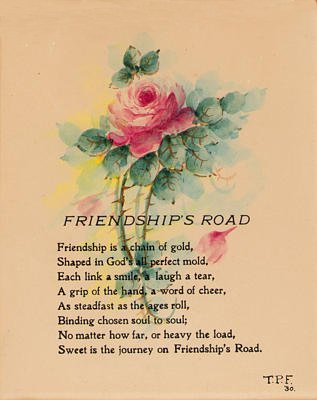
|
Friendship's Road Friendship is a chain of gold, -- T.P.F. '30 |
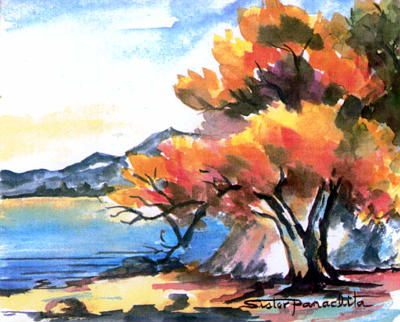
Learning More About the Indian Culture
While the evidence in the early campus obituary ledgers began to mount during the day, my reading and study of the Indian culture in books during the evening hours began to bear fruit. Although I had received no evidence from the elders of the tribal council to confirm either the legend or the curse, I was fortunate to meet another Potawatomi descendant who was researching her own family's Indian heritage.
Our common goals meshed nicely. She suggested many old books on Indians she'd discovered herself and we were soon sharing our "finds" with one another. Many things I read about I was able to verify with my Indian friend. "I don't think they did those kind of things," she said, when I mentioned the so-called "curse on the lakes." She told me that was a white man's term that she doubted the Indians had that word in their language. She then began to explain some of the old Indian beliefs handed down to her which I found most interesting. How the early Indians were told by their elders, "A flood is coming [the white man], learn to swim." It gave me a new appreciation for the Indian culture and the reverence they had for nature, long before white men learned the merits of preserving the environment.
She spoke of the meaning of life to an Indian. That the circle was the central metaphor for Indian spirituality. The Indian believed that life is a circle that begins when you're born, through birth, childhood, marriage and old age. Those just born and elders are closest to God. Indians believe that incidents in the lives of their ancestors are memories in their minds. She went on to explain more of what she had learned from researching her own heritage about what Indians believe and she quoted an Indian paper:
Indian women are Keepers of the Water and the men are Keepers of the Fire. They believe that these two things sustain life. That if you take care of them, they will take care of you.(208)
She said:
Early Indians believed that everything created by God the Creator has a spirit. That water, rocks, trees, plants and people have a spirit. They are taught to honor and respect the spirit in everything in nature, created and seeded by Father Sun and nurtured by Mother Earth. That Indian art often portrays women because a woman symbolizes life and the foundation of the family.
She quoted again the Indian newspaper:
Earth is the mother and it needs blood [water] to give life. Like Earth, women are the givers of life and they are entrusted to be Keepers of the Water. They believe water is the spark of life. That when you take sand and seed, you need water to spark that life, that growth.'
She told me that the rivers, lakes and water are Mother earth's blood, and the soil is her body. The parallel in Christian beliefs came to mind: The wine is my blood and the bread my body.
And she went on:
When an Indian dies he must cross the river to get to the happy hunting ground. The happy hunting ground is the Indian's Heaven and the river to cross is the test he must pass to reach it. If an Indian does not pass the test he falls into the river and becomes a minnow to feed the fishes."
"An Indian purgatory perhaps," I asked her. Her eyes twinkled and she smiled and went on:
The downy feather so much a part of Indian garb, to the mind of the Indian, is a bridge from the spirit world to ours.
Everything that has a spirit, must be honored and respected. For instance, Indians believe if tobacco is placed down in a respectful manner at the river's edge [like a prayer or lighting a candle], the river will show you where to cross safely. In other words, If you don't honor and respect the power of nature [the river] you are putting your life in danger. The spirit of a person goes into whatever comes in contact with the grave. Animals eat the grass, the spirit goes into the animal.
I recalled a story I'd found on my own in an early Scholastic. When an Indian was asked why he couldn't understand the white man's religion. He said:
Because white man could do no wrong, and if he did, he was forgiven by his priest on Sunday. Indian taught to honor his father and mother and creator everyday. He honored Father [Sun] for warmth and light to grow food and Mother [Earth] for life. When we die we replenish Mother Earth. Mother earth is where we come from and where we return. When we play the drums at Pow Wow's they represent the heartbeat of Mother Earth.
I was touched by this new insight into the Indian beliefs, the simplicity and honesty of a culture previously totally unknown to me. How fearful we all are of the unknown, until we gain an understanding of it.
Impressed with this new view of their culture, I pondered what she had said. Then I remembered reading of the illnesses attributed to the lakes that had almost wiped out the University. Arthur J. Hope describes this trying time in his book, Notre Dame -- One Hundred Years:
At various times during eight years, from 1847 to 1855, an exhausting epidemic of malarial fever and cholera so oppressed the faculty and students that the University almost closed its doors. . . . Up at Bertrand, conditions were terrible. Five persons, two professed Sisters, two novice Sisters, and one postulant, died about the same time. At Notre Dame death came to five Brothers and three postulants. . . . The dead were taken to the cemetery at night and buried without any religious solemnity. Conditions, however, could hardly be kept secret, and when professors did not appear for class, the students suspected the worst. Their fears were confirmed when, day after day, the mounds of sandy clay increased in the cemetery.
In South Bend, and in surrounding towns, they were saying openly that there must be something about Notre Dame itself that was causing all this sickness. . . . Others professed a more plausible solution. Some said that it was caused by a certain fish that the Indians had always regarded as poisonous, and of which there was an abundance in the lakes; others decided that the cause lay in the drinking water; the greater majority, however, laid the blame on the marsh land that surrounded the lakes. And this latter opinion was shared by Father Sorin. (209)
About this same time, in one of Father Sorin's circular letters he makes this observation about those trying times. It brought to mind his own courage and indomitable spirit during the aftermath of the disastrous fire that destroyed the main building. It begins, Rev. Dear Friends:
You are all aware that the history of our Congregation in this country, from beginning to end, is a long chain of providential interferences, where the effects of prayer are plainly printed on every link. Every year bears testimony to this fact; everything has been obtained, thus far, by prayer; of its efficacy we should never need proof. But encouraged by so many astonishing marks of protection and solicitude, we should always pray with unbounded confidence, however great and pressing our necessities may be.(210)
I wondered if there might also have been those, at the time, who spoke of the epidemic of death and illness as an Indian Curse -- a disease of the lake -- retribution against the early white settlers for the Indian removal and the taking of their homeland. The writer of the newspaper article had said, "perhaps the tale (of the tree) was linked to the curse." He may have heard of the curse on the river and assumed they might be related or confused it with the history of the diseased lakes on campus.
As it turned out, the owner of the land across (U.S. 31) from St. Mary's Lake had built a dam in the ravine (St. Mary's Creek) below the outlet for the lake which emptied into the St. Joseph River. This dam was there even upon Sorin's arrival and it was this damming of the creek and the high level of the lake which created the appearance of one lake and the marshland that was the suspected cause of the epidemic. Whether or not this was the reason, when Sorin sent men over to destroy the dam, and the lakes were lowered 8 feet, there was no more sickness on campus. Sorin's action, after continual delays to negotiate with the owner, finally effected a sale. The land purchased was offered to the Sisters of the Holy Cross and is now the location of Saint Mary's College.
Indians were known for their reverence for nature. They blended with it and did not disturb it, leaving it as they found it. White men had dammed the rivers and destroyed the wetlands cutting down the forests in their lust for land and power. They had not honored or respected the power of the rivers and lakes and many times the force of nature had wreaked havoc on those who disturbed its flood plains. It's nature's way. When the flood plains are preserved, ditches are not needed. The owner of the creek land -- not Sorin -- had built the dam and disturbed the water's natural course putting human lives at risk.
People who settle too closely to the natural floodplains of the rivers or disturb its natural course take the same risk. To the Indian mind, when they do not respect its power, they are not honoring "its spirit" and it will show its displeasure as it did when the Mississippi overflowed its banks and destroyed everything in its raging path. The Indians believe that if you continue raping Mother Earth she is going to retaliate, as history is continually proving.
My Indian friend told me of The Mishomis Book (Mishomis means grandfather) of Indian beliefs passed on for thousands of years. She explained it this way:
You know how the Christians have The Book of Revelations, well the Indians have one too. In it, they speak of the coming of a light-skinned race. They say humankind is going to come to the crossroads. There will be two roads to take, two choices to make. One will be the road to technology and one the road to spirituality. If the road to technology is chosen -- when there is a house in the sky [a space station?] -- the earth will come to an end.
If people continue to choose the road to the Spirit, the earth will go back to the repopulation of the animals and the world will be as it once was, all human necessities will be supplied.
The simple wisdom in those beliefs I have pondered many times since.
**********
An unexpected sweet surprise occurred in the midst of my Indian research. My brother who worked on St. Stan's Grotto appeared at my door unexpectedly one evening. He had just returned from a motorcycle trip out West and stopped by to tell me all about it. As he got up to leave, he grinned at me, handed me a little box, and said: "When I saw this I thought of you. I thought you'd like to have it."
Inside was a delicate, gleaming, silver necklace with a very unusual pendent attached to it. Before I could ask him its significance, he told me, it was called a "Dreamcatcher." That it was made by the Indians, and because it had a story behind it, he just knew I'd like it. What he didn't know was that I had been researching the Indians on campus for some time. I couldn't believe it, it was such a lovely gesture and such timely one.
I knew my Indian friend would have the story behind it. Unfortunately, I did not write it down. at the time. We met mysteriously, purely by chance, during my Indian research, and she disappeared from the scene just as mysteriously. Wherever she is, I hope she will see this Web Site someday and will share her lovely version of it. This is what I remember of the story she told me. She said it was an Indian custom to hang a "Dreamcatcher" (they come in all different sizes and materials) over the head of the beds of their children to insure their happy dreams. That the web in the circle of the Dreamcatcher would filter out the bad dreams, and catch the good ones (represented by the pearls) and they would slide down the feathers into their heads.
Like my Lourdes medallion, the "Dreamcatcher" has become an integral part of my research because it represents to me not only all the dreams I've caught in my lifetime but also all the good energies I have encountered since I first began my research on the campus in the autumn of 1991. I wear them often when I'm "On the Trail" and I want good things to happen. The inspiration to write this story is one of those dreams come true, and the opportunity to share it, another. I offer my own archival adventures in completing this documentation as living proof that it's never too late to follow your dreams.
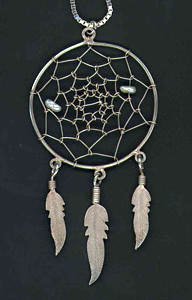
Always Have a Dream
In life
There is nothing more sweet,
Than when a dream and you meet,
Then all of life
Becomes a delicious treat.
The beauty
Of nature's sights and sounds
Will on this spacious earth abound,
When in this world you've finally found,
A dream to build your life around.
D.V.C.